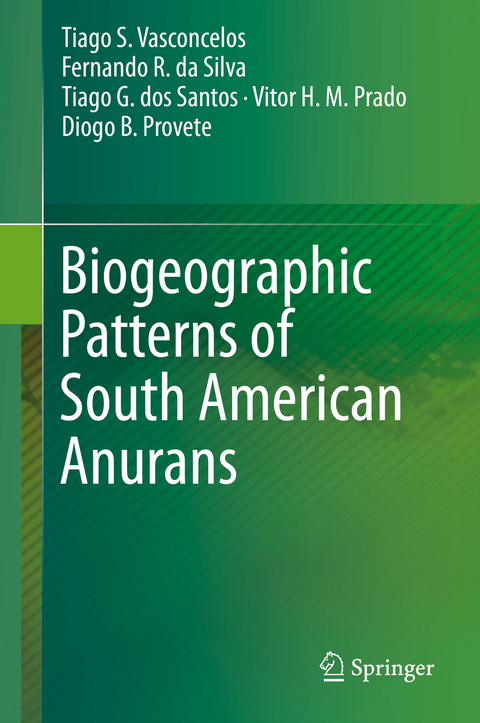
Biogeographic Patterns of South American Anurans
Springer International Publishing (Verlag)
978-3-030-26295-2 (ISBN)
TS Vasconcelos obtained his BS in Biological Sciences (2002) and MSc in Animal Biology (2005) both from the Sao Paulo State University (UNESP/Sao Jose do Rio Preto, SP, Brazil), and PhD in Biological Sciences-Zoology (2009) from the UNESP/Rio Claro (SP, Brazil). He was a post-doctoral fellow in the Department of Ecology and Evolutionary Biology at the University of California - Irvine (Prof. Dr. Bradford A. Hawkins' lab: 2010-2011). From 2012 to 2016 he was a Young Researcher fellow at the Department of Biological Sciences (UNESP/Bauru, SP, Brazil). Currently, he is a post-doctoral fellow in the Department of Biological Sciences (UNESP/Bauru, SP, Brazil). His research focus on understanding patterns of species distributions in the Neotropics. FR da Silva obtained his BS in Biological Sciences (2004) from the Sao Paulo State University (UNESP/Assis, SP, Brazil) and both MSc (2007) and PhD (2011) in Animal Biology from UNESP/São José do Rio Preto (SP, Brazil). He holds a Professor position at the Department of Environmental Sciences, Federal University of São Carlos (UFScar/Sorocaba, SP, Brazil) since 2011. His research tries to understand the processes and mechanisms underlying amphibian species distribution at different spatial scales, focusing mainly on anuran species of Atlantic Forest and Cerrado. TG Santos obtained his BS in Biological Science (2003) from Federal University of Santa Maria (UFSM, RS, Brazil), and both MSc in Animal Biology (2005) and PhD in Biological Sciences-Zoology (2009) from the São Paulo State University (UNESP, SP, Brazil). He spent one year as post-doctoral fellow from the São Paulo State University (UNESP/Rio Claro, SP, Brazil). Since 2010, he holds a Professor position at the Federal University of Pampa (UNIPAMPA). Currently, he also contributes to the Pos-Graduate Program in Animal Biodiversity of the Federal University of Santa Maria (UFSM), having mentored students for the MSc and PhD degrees in researches on diversity and natural history of herpetofauna (especially in the Brazilian subtropical ecosystems). VHM Prado obtained his BS in Biological Sciences (2003), MSc (2006) and PhD (2009) in Animal Biology from the Sao Paulo State University (UNESP/Sao Jose do Rio Preto, SP, Brazil). He was a post-doctoral fellow in the São Paulo State University (UNESP/Rio Claro, SP, Brazil) (2010-2013) with a six-month period as visiting scholar (2011-2012) at the Pedro Peres-Neto's lab at the Université du Québec à Montréal (Canada). Currently, he is lecturer and researcher at the Goiás State University (UEG), Anápolis, GO, Brazil. DB Provete obtained his BS in Biological Sciences (2006) from the Federal University of Alfenas (MG, Brazil), MSc in Animal Biology (2010) from the São Paulo State University (UNESP/São José do Rio Preto, SP, Brazil), and a PhD in Ecology and Evolution from the Federal University of Goiás (2015) (GO, Brazil). He also spent one year as a visiting scholar during his PhD at the Mathew Leibold's lab at the University of Texas at Austin (USA). Before joining the Faculty board of the Federal University of Mato Grosso do Sul as an Assistant Professor in late 2017, he was a FAPESP post-doc fellow at the Federal University of São Carlos (Sorocaba, Brazil), and spent 6 months in 2015 in the Alexandre Antonelli's lab in the University of Gothenburg (Sweden) conducting research on biogeography and macroevolution of Atlantic Forest anurans. He is broadly interested in how micro- and macroevolutionary processes interact to determine present-day ecological patterns in communities at distinct spatial and temporal scales.
An Introduction to the Biogeography of South American Anurans.- South American Anurans: Species Diversity and Description Trends Through Time and Space.- Patterns of Species Richness, Range Size, and their Environmental Correlates of South American Anurans.- Spatial Distribution of Phylogenetic Diversity of South American Anurans.- Geographical Patterns of Functional Diversity of South American Anurans.- Biogeographic Regionalization of South American Anurans.- Spatial Conservation Prioritization for the Anuran Fauna of South America
| Erscheinungsdatum | 12.09.2019 |
|---|---|
| Zusatzinfo | X, 149 p. 16 illus., 13 illus. in color. |
| Verlagsort | Cham |
| Sprache | englisch |
| Maße | 155 x 235 mm |
| Gewicht | 405 g |
| Themenwelt | Naturwissenschaften ► Biologie ► Ökologie / Naturschutz |
| Naturwissenschaften ► Biologie ► Zoologie | |
| Schlagworte | amphibian distribution patterns • amphibians in South America • biogeography of amphibians • conservation of amphibians in South America • macroecology of amphibians |
| ISBN-10 | 3-030-26295-2 / 3030262952 |
| ISBN-13 | 978-3-030-26295-2 / 9783030262952 |
| Zustand | Neuware |
| Haben Sie eine Frage zum Produkt? |
aus dem Bereich


